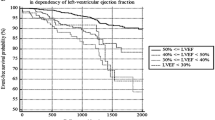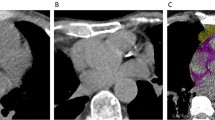Abstract
Purpose
To examine the association between myocardial fat, a poorly understood finding frequently observed on non-contrast CT, and all-cause mortality in patients with and without a history of prior MI.
Materials and methods
A retrospective cohort from a diverse urban academic center was derived from chronic myocardial infarction (MI) patients (n = 265) and three age-matched patients without MI (n = 690) who underwent non-contrast chest CT between 1 January 2005-31 December 2008. CT images were reviewed for left and right ventricular fat. Electronic records identified clinical variables. Kaplan-Meier and Cox proportional hazard analyses assessed the association between myocardial fat and all-cause mortality. The net reclassification improvement assessed the utility of adding myocardial fat to traditional risk prediction models.
Results
Mortality was 40.1% for the no MI and 71.7% for the MI groups (median follow-up, 6.8 years; mean age, 73.7 ± 10.6 years). In the no MI group, 25.7% had LV and 49.9% RV fat. In the MI group, 32.8% had LV and 42.3% RV fat. LV and RV fat was highly associated (OR 5.3, p < 0.001). Ventricular fat was not associated with cardiovascular risk factors. Myocardial fat was associated with a reduction in the adjusted hazard of death for both the no MI (25%, p = 0.04) and the MI group (31%, p = 0.018). Myocardial fat resulted in the correct reclassification of 22% for the no MI group versus the Charlson score or calcium score (p = 0.004) and 47% for the MI group versus the Charlson score (p = 0.0006).
Conclusions
Patients with myocardial fat have better survival, regardless of MI status, suggesting that myocardial fat is a beneficial biomarker and may improve risk stratification.
Key Points
• Myocardial fat is commonly found on chest CT, yet is poorly understood
• Myocardial fat is associated with better survival in patients with and without prior MI and is not associated with traditional cardiovascular risk factors
• This finding may provide clinically meaningful prognostic value in the risk stratification of patients






Similar content being viewed by others
Abbreviations
- CAD:
-
Coronary artery disease
- CT:
-
Computed tomography
- LV:
-
Left ventricle
- MI:
-
Myocardial infarction
- NRI:
-
Net reclassification improvement
- RV:
-
Right ventricle
References
Tansey DK, Aly Z, Sheppard MN (2005) Fat in the right ventricle of the normal heart. Histopathology 46:98–104
Caruso G, Frassanito F, Serio G, Pennella A (1989) Is adipose tissue a normal component of the myocardium? Eur Heart J 10(Suppl D):89–91
Fontaine G, Fontaliran F, Zenati O et al (1999) Fat in the heart. A feature unique to the human species? Observational reflections on an unsolved problem. Acta Cardiol 54:189–194
Carpenter HM (1962) Myocardial fat infiltration. Am Heart J 63:491–496
Baroldi G, Silver MD, De Maria R, Parodi O, Pellegrini A (1997) Lipomatous metaplasia in left ventricular scar. Can J Cardiol 13:65–71
Su L, Siegel JE, Fishbein MC (2004) Adipose tissue in myocardial infarction. Cardiovasc Pathol 13:98–102
Beltrami AP, Urbanek K, Kajstura J et al (2001) Evidence that human cardiac myocytes divide after myocardial infarction. N Engl J Med 344:1750–1757
Lu M, Zhao S, Jiang S et al (2013) Fat deposition in dilated cardiomyopathy assessed by CMR. JACC Cardiovasc Imaging 6:889–898
Kimura F, Matsuo Y, Nakajima T et al (2010) Myocardial fat at cardiac imaging: how can we differentiate pathologic from physiologic fatty infiltration? Radiographics 30:1587–1602
Saremi F, Saremi A, Hassani C et al (2015) Computed tomographic diagnosis of myocardial fat deposits in sarcoidosis. J Comput Assist Tomogr 39:578–583
Hannoush H, Sachdev V, Brofferio A et al (2015) Myocardial fat overgrowth in Proteus syndrome. Am J Med Genet A 167a:103–110
Bushberg JT, Seibert JA, Leidholdt EM (2011) Essential physics of medical imaging. Wolters Kluwer Health, Philadelphia
Raney AR, Saremi F, Kenchaiah S et al (2008) Multidetector computed tomography shows intramyocardial fat deposition. J Cardiovasc Comput Tomogr 2:152–163
Durmaz MS, Demirtas H, Aralasmak A, Ozkaynak C (2013) Evaluation of myocardial fat deposition by multislice computed tomography. Asian Cardiovasc Thorac Ann 21:655–660
Kim E, Choe YH, Han BK et al (2007) Right ventricular fat infiltration in asymptomatic subjects: observations from ECG-gated 16-slice multidetector CT. J Comput Assist Tomogr 31:22–28
Ichikawa Y, Kitagawa K, Chino S et al (2009) Adipose tissue detected by multislice computed tomography in patients after myocardial infarction. JACC Cardiovasc Imaging 2:548–555
Shemesh J, Henschke CI, Shaham D et al (2010) Ordinal scoring of coronary artery calcifications on low-dose CT scans of the chest is predictive of death from cardiovascular disease. Radiology 257:541–548
Austin SR, Wong YN, Uzzo RG, Beck JR, Egleston BL (2015) Why summary comorbidity measures such as the Charlson Comorbidity Index and Elixhauser Score work. Med Care 53:e65–e72
Pencina MJ, D'Agostino RB Sr, D'Agostino RB Jr, Vasan RS (2008) Evaluating the added predictive ability of a new marker: from area under the ROC curve to reclassification and beyond. Stat Med 27:157–172 discussion 207-112
Yeboah J, McClelland RL, Polonsky TS et al (2012) Comparison of novel risk markers for improvement in cardiovascular risk assessment in intermediate-risk individuals. JAMA 308:788–795
Jacobi AH, Gohari A, Zalta B, Stein MW, Haramati LB (2007) Ventricular myocardial fat: CT findings and clinical correlates. J Thorac Imaging 22:130–135
Schelbert EB, Cao JJ, Sigurdsson S et al (2012) Prevalence and prognosis of unrecognized myocardial infarction determined by cardiac magnetic resonance in older adults. JAMA 308:890–896
Arenja N, Mueller C, Ehl NF et al (2013) Prevalence, extent, and independent predictors of silent myocardial infarction. Am J Med 126:515–522
Turkbey EB, Nacif MS, Guo M et al (2015) Prevalence and correlates of myocardial scar in a US cohort. JAMA 314:1945–1954
Mordi I, Radjenovic A, Stanton T et al (2015) Prevalence and prognostic significance of lipomatous metaplasia in patients with prior myocardial infarction. JACC Cardiovasc Imaging 8:1111–1112
Bays HE (2011) Adiposopathy is "sick fat" a cardiovascular disease? J Am Coll Cardiol 57:2461–2473
Rosito GA, Massaro JM, Hoffmann U et al (2008) Pericardial fat, visceral abdominal fat, cardiovascular disease risk factors, and vascular calcification in a community-based sample: the Framingham Heart Study. Circulation 117:605–613
Liu J, Fox CS, Hickson D et al (2010) Pericardial adipose tissue, atherosclerosis, and cardiovascular disease risk factors: the Jackson heart study. Diabetes Care 33:1635–1639
Ding J, Hsu FC, Harris TB et al (2009) The association of pericardial fat with incident coronary heart disease: the Multi-Ethnic Study of Atherosclerosis (MESA). Am J Clin Nutr 90:499–504
Ding J, Kritchevsky SB, Harris TB et al (2008) The association of pericardial fat with calcified coronary plaque. Obesity (Silver Spring) 16:1914–1919
McClain J, Hsu F, Brown E et al (2013) Pericardial adipose tissue and coronary artery calcification in the Multi-ethnic Study of Atherosclerosis (MESA). Obesity (Silver Spring) 21:1056–1063
Larsen BA, Laughlin GA, Saad SD, Barrett-Connor E, Allison MA, Wassel CL (2015) Pericardial fat is associated with all-cause mortality but not incident CVD: the Rancho Bernardo Study. Atherosclerosis 239:470–475
Kollar K, Cook MM, Atkinson K, Brooke G (2009) Molecular mechanisms involved in mesenchymal stem cell migration to the site of acute myocardial infarction. Int J Cell Biol 2009:904682
Zuk PA (2010) The adipose-derived stem cell: looking back and looking ahead. Mol Biol Cell 21:1783–1787
Madonna R, Geng YJ, De Caterina R (2009) Adipose tissue-derived stem cells: characterization and potential for cardiovascular repair. Arterioscler Thromb Vasc Biol 29:1723–1729
Acknowledgements
The preliminary findings were presented as an oral presentation at the Radiological Society of North America Annual Meeting, November 29, 2016, Chicago, IL.
Funding
This study has received funding by National Institutes of Health Clinical and Translational Science Awards Grant Number 1UL-1TR001073 from the National Center for Advancing Translational Sciences.
Author information
Authors and Affiliations
Corresponding author
Ethics declarations
Guarantor
The scientific guarantor of this publication is Dr. Anna S. Bader.
Conflict of interest
The authors of this manuscript declare relationships with the following companies: The spouse of L.B.H. is a board member of Kryon.
Statistics and biometry
One of the authors has significant statistical expertise.
Informed consent
The requirement for written informed consent was waived by the Institutional Review Board.
Ethical approval
Institutional Review Board approval was obtained.
Methodology
• retrospective
• observational
• performed at one institution
Rights and permissions
About this article
Cite this article
Bader, A.S., Levsky, J.M., Zalta, B.A. et al. Ventricular Myocardial Fat: An Unexpected Biomarker for Long-term Survival?. Eur Radiol 29, 241–250 (2019). https://doi.org/10.1007/s00330-018-5546-4
Received:
Revised:
Accepted:
Published:
Issue Date:
DOI: https://doi.org/10.1007/s00330-018-5546-4




